-
THE CURWEN STUDIO | LITHOGRAPHY
We offer collaborative printmaking for artists and photographers using all forms of lithography to make original or reprographic editionsThe Curwen Studio is a printmaker and publisher of fine art lithographic prints. Originally founded in 1958 as a subsidiary of the Curwen Press, which itself was founded in 1863 by The Reverend John Curwen as a means of producing hymn sheets for his congregation.
Due to the emergence of artists’ original prints as publications in their own right The Curwen Studio was set up in 1958 under the management of renowned printmaker Stanley Jones MBE.
There followed a period when artists including Henry Moore, Barbara Hepworth, Graham Sutherland, Elisabeth Frink and John Piper produced many important lithographs at the Studio.
In 2014 The Curwen Studio found a new London home at Worton Hall Studios. We continue to work with leading contemporary artists, publishers and museums from around the world.
-
LITHOGRAPHY GUIDE
Lithography is a planographic form of printing. It differs from other processes where the image is raised (Lino/Woodblock), or recessed (intaglio: copper/wood engraving or etching). Lithography depends on the interaction of two incompatible substances, grease and water, on a prepared flat surface. The means of making marks on the stone/plates are very similar to those used for drawing/painting and consequently artists immediately feel comfortable using them, unlike having to come to terms with handling an etching needle on copper plate for example.
Once the artist has completed the drawing, the prints are created on presses where an alternate use of damping and inking ensures that only the artist's drawn image receives the application of ink which, when printed on suitable paper, provides the lithographic print. The choice and number of colours available in our printing process is unlimited, giving greater flexibility to the artist.
The lithographic method on stone is the original process as discovered by Alois Senefelder at the end of the 18th century. An abundance of fine grain limestone occurred where he lived in Bavaria and this material formed the basis on which his experiments were made. The concept was based on chemical interaction of grease and water on the flat surface of a prepared limestone block.
MULTI-PROCESS PRINTMAKING
LITHOGRAPHY PROCESS
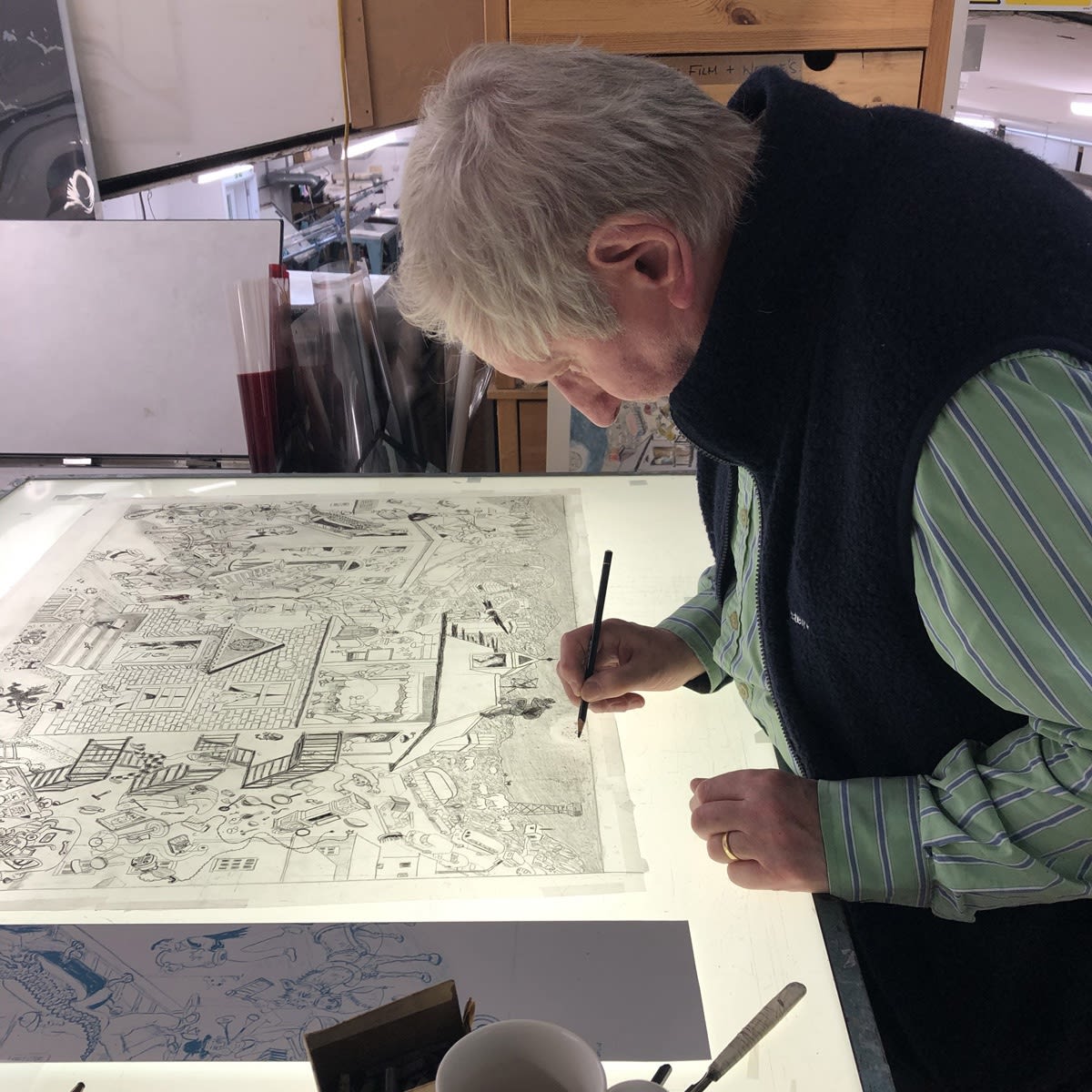
Stone and Zinc Plate (autographic)
Marks can be drawn directly onto the surface using grease-based substances, from lithographic crayon, to tusche washes. If the drawing needs to be done on location and the thought of carrying a stone or plate around is unappealing, then there is the option.
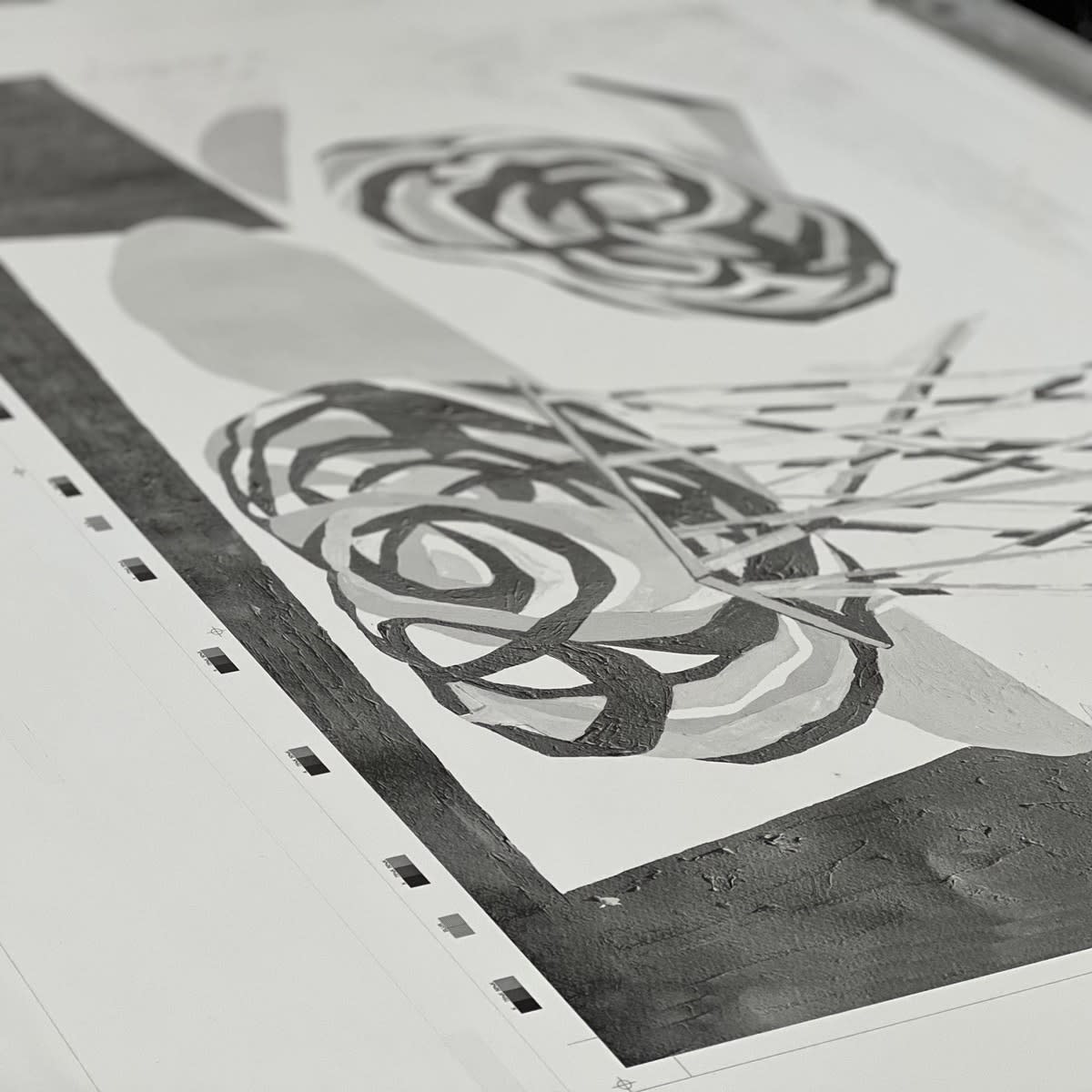
Polymer coated photo plate (autographic)
There are a number of ways of approaching this process, but for ease of description, the artist draws directly onto a film or paper that has a degree of translucency and all the information is transferred to the plate by exposure under UV light.
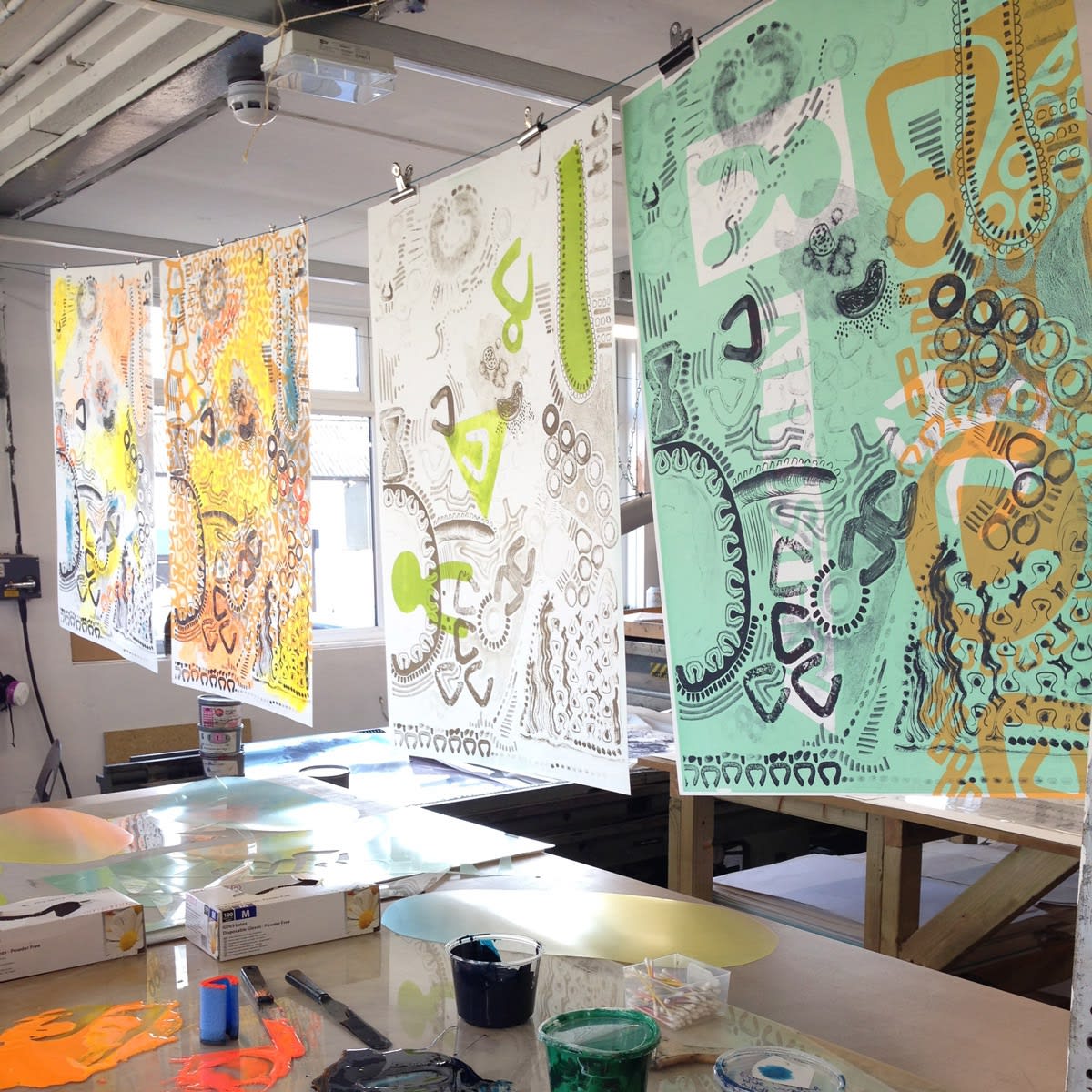
Reproduction use of polymer coated photo plate
This process is used for making a print from an existing image. First a transparency, scan or high resolution digital file is needed, from which a set of films are made in order to transfer the information to plate.

Photographic Contone
We have developed a process for photography that allows us to print a continuous tone photographic image, which means that the quality of the image is not lost by being broken up by dot screens.
PRINT SIZE
LITHOGRAPHY | PRINT & PAPER SIZES
- Printable Area - 77cm X 102cm
- Sheet Sizes Upto - 154cm X 102cm
- Multiple Paper Types Available
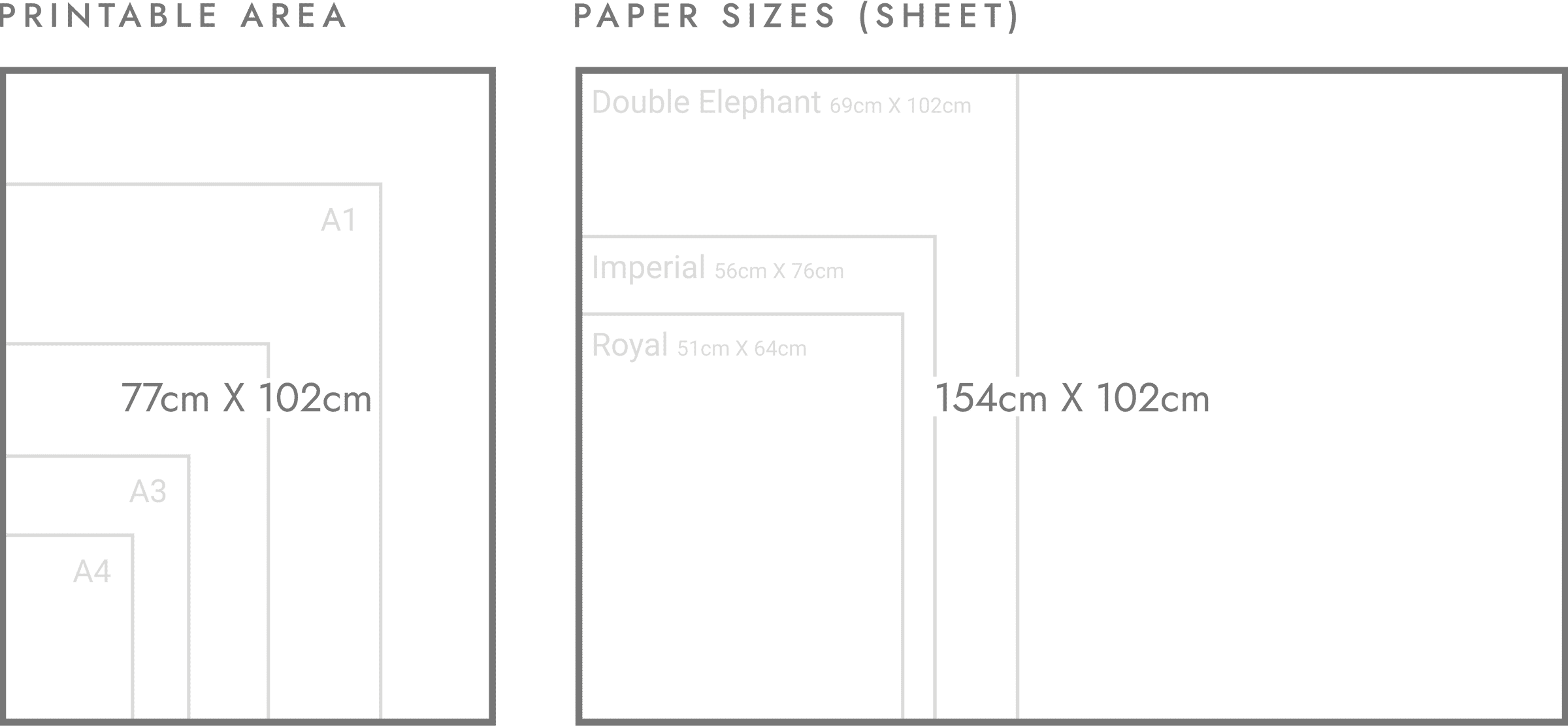
PAPER OPTIONS
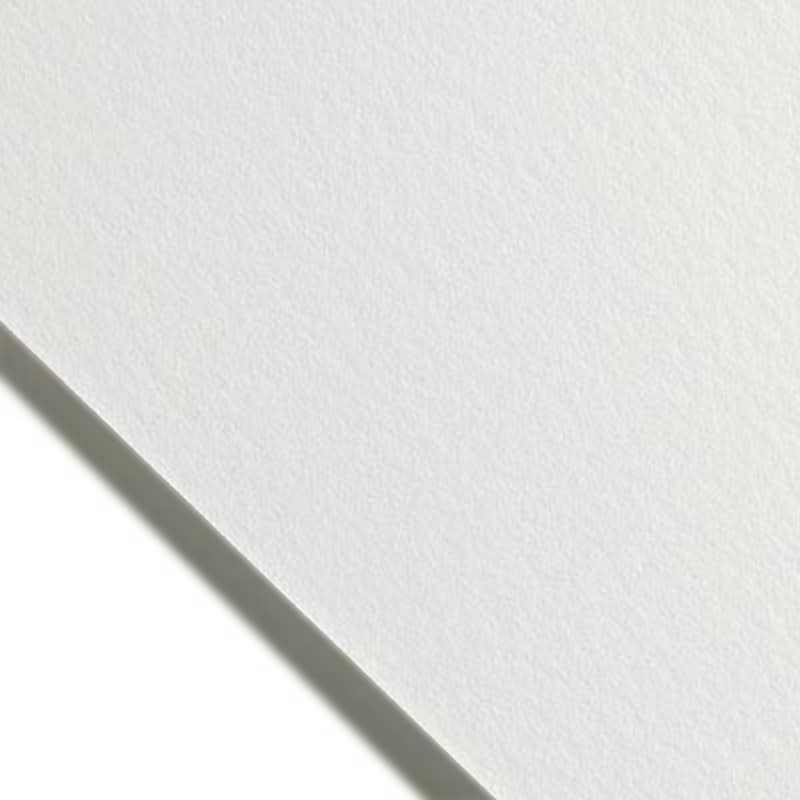
SATIN PAPERS
Fine art satin paper offers a smooth, slightly textured surface with a soft sheen, combining the elegance of matte finishes with a subtle touch of gloss. It enhances colour vibrancy while maintaining deep blacks and fine detail, making it ideal for high-quality art prints and photography. The satin finish minimises glare and fingerprints, providing a refined, professional appearance suitable for framing and display.
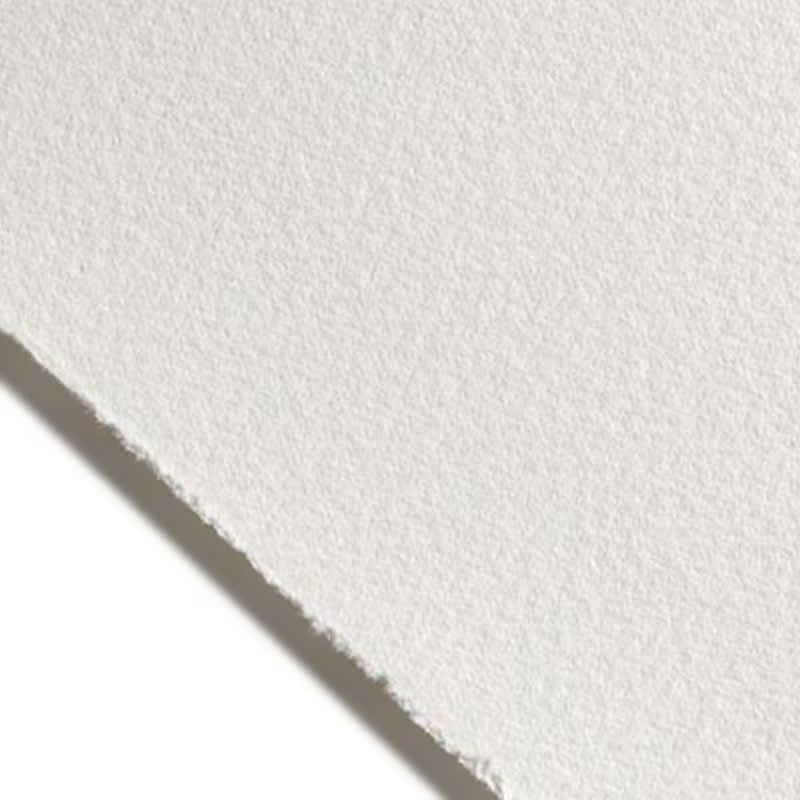
VELVET PAPERS
Velvet paper has a luxurious, soft texture with a rich, matte finish that gives artwork and photographs a sophisticated, tactile feel. Its textured surface enhances depth and detail, offering a slightly muted and painterly effect, making it perfect for fine art reproductions and high-end prints. The non-reflective quality ensures minimal glare, ideal for displaying in various lighting conditions, while its absorbent nature provides excellent color retention and subtle tonal variations.

Textured Papers
Textured paper has a distinctive surface that adds a tactile dimension to prints, enhancing the visual depth and character of artwork and photographs. Its rich, organic feel creates an authentic, hand-crafted look, making it ideal for fine art reproductions and illustrations. The textured finish diffuses light, reducing glare and giving images a soft, natural appearance, while its high absorbency ensures vibrant colours and intricate details are preserved.

SPECIALIST SUBSTRATES
Special substrates like canvas, fabrics, and holographic, gold, or silver mirror finishes offer diverse, eye-catching effects. Canvas provides a textured, traditional look, while fabrics add a soft, tactile quality. Holographic substrates create prismatic colour shifts, and gold or silver mirror options give a sleek, metallic sheen. Ideal for distinctive, high-impact visuals and multi-dimensional pieces.
PACKAGING & SHIPPING
THE HISTORY OF CURWEN STUDIO

THE CURWEN STUDIO
Many galleries and publishers also choose the Curwen Studio to produce editions for their artists and clients including Washington Green, De Montfort Fine Art Publishing, Thames & Hudson, Marlborough Fine Art, Richard Nathanson, Belgravia Gallery, Browse and Darby, J Hewett & Sons, Ashgate Publishing, Curwen Gallery, ETOA, Oriel Yns Mon, The Geffrey Museum, Aldeborough Productions, Eyestorm, Northcote Gallery, Laz Inc., Shell Art Collection, TAG Fine Arts, Blenheim Palace, Tate Britain and Tate Enterprises, Bedford Gallery and Cecil Higgins Museum, Liberty and many others.
The Curwen Studio also enjoys a close link with Tate Britain; donating an archive of prints in 1975 for the exhibition Artists at Curwen and in 2008 celebrated the 50th Anniversary of the Studio with a further display at Tate Britain. Tate Publishing commissioned the publication ‘Art & Print: The Curwen Story’, by Alan Powers. Special Limited Editions by Paula Rego, Mark Hearld, Antony Micallef and Mary Dalton were also sold via Tate outlets along with a further Curwen edition by Mark Hearld commissioned by Tate.
LITHOGRAPHY GUIDE
Lithography is a planographic form of printing. It differs from other processes where the image is raised (Lino/Woodblock), or recessed (intaglio: copper/wood engraving or etching). Lithography depends on the interaction of two incompatible substances, grease and water, on a prepared flat surface. The means of making marks on the stone/plates are very similar to those used for drawing/painting and consequently artists immediately feel comfortable using them, unlike having to come to terms with handling an etching needle on copper plate for example.
Once the artist has completed the drawing, the prints are created on presses where an alternate use of damping and inking ensures that only the artist's drawn image receives the application of ink which, when printed on suitable paper, provides the lithographic print. The choice and number of colours available in our printing process is unlimited, giving greater flexibility to the artist.
The lithographic method on stone is the original process as discovered by Alois Senefelder at the end of the 18th century. An abundance of fine grain limestone occurred where he lived in Bavaria and this material formed the basis on which his experiments were made. The concept was based on chemical interaction of grease and water on the flat surface of a prepared limestone block.
LITHOGRAPHY PROCESS
-

Stone and Zinc Plate (autographic)
Marks can be drawn directly onto the surface using grease-based substances, from lithographic crayon, to tusche washes. If the drawing needs to be done on location and the thought of carrying a stone or plate around is unappealing, then there is the option.

Polymer coated photo plate (autographic)
There are a number of ways of approaching this process, but for ease of description, the artist draws directly onto a film or paper that has a degree of translucency and all the information is transferred to the plate by exposure under UV light.

Reproduction use of polymer coated photo plate
This process is used for making a print from an existing image. First a transparency, scan or high resolution digital file is needed, from which a set of films are made in order to transfer the information to plate.

Photographic Contone
We have developed a process for photography that allows us to print a continuous tone photographic image, which means that the quality of the image is not lost by being broken up by dot screens.
PRINT SIZE
LITHOGRAPHY | PRINT & PAPER SIZES
- Printable Area - 77cm X 102cm
- Sheet Sizes Upto - 154cm X 102cm
- Multiple Paper Types Available


SATIN PAPERS
Fine art satin paper offers a smooth, slightly textured surface with a soft sheen, combining the elegance of matte finishes with a subtle touch of gloss. It enhances colour vibrancy while maintaining deep blacks and fine detail, making it ideal for high-quality art prints and photography. The satin finish minimises glare and fingerprints, providing a refined, professional appearance suitable for framing and display.

VELVET PAPERS
Velvet paper has a luxurious, soft texture with a rich, matte finish that gives artwork and photographs a sophisticated, tactile feel. Its textured surface enhances depth and detail, offering a slightly muted and painterly effect, making it perfect for fine art reproductions and high-end prints. The non-reflective quality ensures minimal glare, ideal for displaying in various lighting conditions, while its absorbent nature provides excellent color retention and subtle tonal variations.

Textured Papers
Textured paper has a distinctive surface that adds a tactile dimension to prints, enhancing the visual depth and character of artwork and photographs. Its rich, organic feel creates an authentic, hand-crafted look, making it ideal for fine art reproductions and illustrations. The textured finish diffuses light, reducing glare and giving images a soft, natural appearance, while its high absorbency ensures vibrant colours and intricate details are preserved.

SPECIALIST SUBSTRATES
Special substrates like canvas, fabrics, and holographic, gold, or silver mirror finishes offer diverse, eye-catching effects. Canvas provides a textured, traditional look, while fabrics add a soft, tactile quality. Holographic substrates create prismatic colour shifts, and gold or silver mirror options give a sleek, metallic sheen. Ideal for distinctive, high-impact visuals and multi-dimensional pieces.

THE CURWEN STUDIO
Many galleries and publishers also choose the Curwen Studio to produce editions for their artists and clients including Washington Green, De Montfort Fine Art Publishing, Thames & Hudson, Marlborough Fine Art, Richard Nathanson, Belgravia Gallery, Browse and Darby, J Hewett & Sons, Ashgate Publishing, Curwen Gallery, ETOA, Oriel Yns Mon, The Geffrey Museum, Aldeborough Productions, Eyestorm, Northcote Gallery, Laz Inc., Shell Art Collection, TAG Fine Arts, Blenheim Palace, Tate Britain and Tate Enterprises, Bedford Gallery and Cecil Higgins Museum, Liberty and many others.
The Curwen Studio also enjoys a close link with Tate Britain; donating an archive of prints in 1975 for the exhibition Artists at Curwen and in 2008 celebrated the 50th Anniversary of the Studio with a further display at Tate Britain. Tate Publishing commissioned the publication ‘Art & Print: The Curwen Story’, by Alan Powers. Special Limited Editions by Paula Rego, Mark Hearld, Antony Micallef and Mary Dalton were also sold via Tate outlets along with a further Curwen edition by Mark Hearld commissioned by Tate.
-









